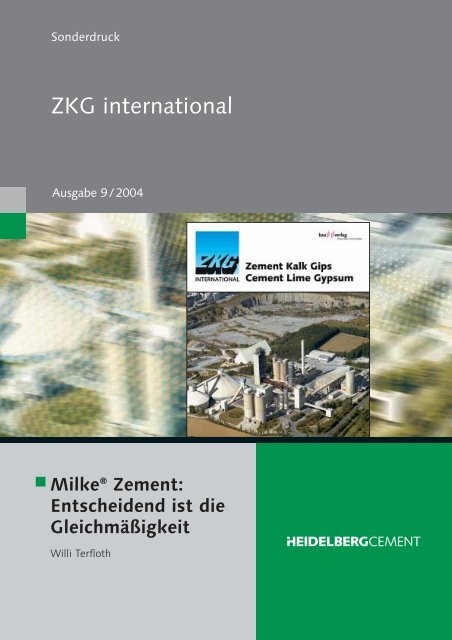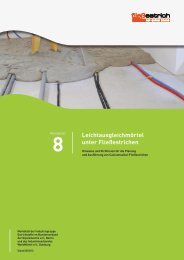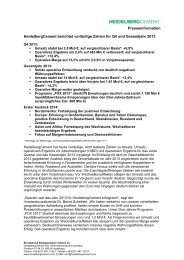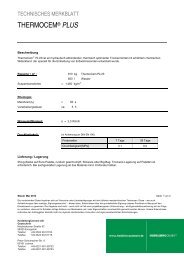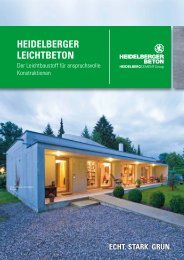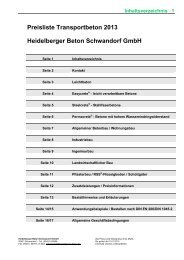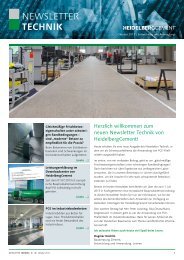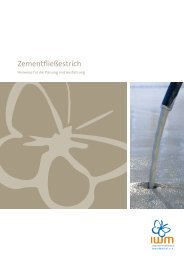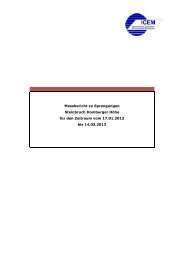Milke Zement: Entscheidend ist die ... - HeidelbergCement
Milke Zement: Entscheidend ist die ... - HeidelbergCement
Milke Zement: Entscheidend ist die ... - HeidelbergCement
Sie wollen auch ein ePaper? Erhöhen Sie die Reichweite Ihrer Titel.
YUMPU macht aus Druck-PDFs automatisch weboptimierte ePaper, die Google liebt.
Sonderdruck<br />
ZKG international<br />
Ausgabe 9 / 2004<br />
<strong>Milke</strong> ® <strong>Zement</strong>:<br />
<strong>Entscheidend</strong> <strong>ist</strong> <strong>die</strong><br />
Gleichmäßigkeit<br />
Willi Terfloth
<strong>Milke</strong> ® <strong>Zement</strong>: <strong>Entscheidend</strong> <strong>ist</strong> <strong>die</strong> Gleichmäßigkeit<br />
<strong>Milke</strong> ® Cement: Uniformity is crucial<br />
Haben Sie schon einmal darüber nachgedacht,welchen Weg <strong>die</strong><br />
kleinen Tüten mit Fliesenkleber, Fugenmörtel, Feinspachtel,<br />
Spezialkleber oder Spachtelmasse genommen haben, um in <strong>die</strong><br />
Regale der Baumärkte zu gelangen? Wer täglich damit zu tun<br />
hat, weiß das und ahnt schon, worum es im folgenden Beitrag<br />
gehen könnte. Das Stichwort <strong>ist</strong> „Bauchemie“, und <strong>Zement</strong><br />
<strong>ist</strong> einer der wichtigsten Rezepturbestandteile der unter dem<br />
Begriff „Bauchemie“ zusammengefassten Produkte.<br />
Für <strong>die</strong>se sensiblen Bauchemie-Produkte muss es allerdings ein<br />
<strong>Zement</strong> mit besonderen Eigenschaften sein. Die Hersteller der<br />
bauchemischen Produkte legen bei dem eingesetzten <strong>Zement</strong><br />
besonderen Wert auf <strong>die</strong> Gleichmäßigkeit in der chemischmineralogischen<br />
Zusammensetzung,in Korngrößenverteilung,<br />
Farbe,Wasseranspruch sowie bei den Erstarrungszeiten und der<br />
Festigkeitsentwicklung.<br />
Die Suche nach einem solchen <strong>Zement</strong> führt uns zum <strong>Zement</strong>werk<br />
<strong>Milke</strong>, zugehörig zu <strong>Zement</strong>werke Geseke, in der<br />
Nähe von Paderborn. Hinter der Bezeichnung „<strong>Zement</strong>werke<br />
Geseke“ der <strong>HeidelbergCement</strong> AG mit Sitz im baden-württembergischen<br />
Heidelberg verbergen sich das weit über<br />
<strong>die</strong> deutschen Grenzen hinaus bekannte <strong>Zement</strong>werk <strong>Milke</strong><br />
(Bild 1) und das inzwischen seit 1996 als Mahlwerk betriebene<br />
Werk Elsa (Bild 2). Die beiden Standorte, nur etwa 1 km<br />
voneinander entfernt, liegen ebenso wie zahlreiche benachbarte<br />
<strong>Zement</strong>werke in der großen westfälischen Bucht, <strong>die</strong><br />
geologisch eine flache Mulde mit Ablagerungen aus der mittleren<br />
Oberkreide (Unterconiac) darstellt. Im Unterconiac<br />
(schloenbachi-Schichten) kam es zur Ablagerung mergeliger<br />
Kalksteine (70–90 % CaCO 3) und kalkiger Mergelsteine<br />
(50–75 % CaCO 3), <strong>die</strong> im Werk <strong>Milke</strong> Rohstoffgrundlage für<br />
<strong>die</strong> dort hergestellten <strong>Zement</strong>e sind (Bilder 3 und 4). <strong>Entscheidend</strong><br />
für <strong>die</strong> Qualität der im Werk <strong>Milke</strong> gebrannten Klinker<br />
<strong>ist</strong> unter anderem <strong>die</strong>ses hochwertige Rohstoffvorkommen.<br />
Die <strong>Zement</strong>herstellung in der Region geht fast 100 Jahre zurück.<br />
1909 wurde mit dem Aufbau der Geseker Kalk- und<br />
<strong>Zement</strong>werke GmbH „Rote Erde“ der Grundstein für das<br />
Werk Elsa gelegt. 1919 folgte <strong>die</strong> Gründung der Kalk- und<br />
1 Luftbildaufnahme <strong>Zement</strong>werk <strong>Milke</strong><br />
1 Aerial photograph of the <strong>Milke</strong> cement works<br />
Have you ever thought how the small containers filled with tile<br />
adhesive, pointing mortar, fine filler, special adhesive or filling<br />
compound reach the shelves in the builders merchants? Anyone<br />
involved on a daily basis knows this and will already have<br />
guessed the probable direction of the following article. The<br />
keywords are “construction chem<strong>ist</strong>ry” and cement is one of<br />
the most important constituents in the mix formulations for<br />
the products covered by the term “construction chem<strong>ist</strong>ry”.<br />
However, these sensitive construction chem<strong>ist</strong>ry products need<br />
a cement with special properties. The manufacturers of construction<br />
chem<strong>ist</strong>ry products place particular value on the<br />
uniformity of the chemical and mineralogical composition,<br />
particle size d<strong>ist</strong>ribution, colour and water demand of the cement<br />
used as well as its setting times and strength development.<br />
The search for such a cement leads us to the <strong>Milke</strong> cement<br />
works, part of the Geseke Works Group, near Paderborn. Concealed<br />
behind the name “Geseke Works Group” of <strong>HeidelbergCement</strong><br />
AG with its head office in Heidelberg, Baden-<br />
Württemberg,are the <strong>Milke</strong> cement works (Fig. 1),well known<br />
far beyond the borders of Germany, and the Elsa works<br />
(Fig. 2), which has been operated since 1996 as a grinding<br />
plant. Like numerous adjacent cement works the two sites,<br />
which are only one kilometre apart, lie in the large Westphalian<br />
basin. Geologically this is a shallow syncline with deposits<br />
from the middle Upper Cretaceous (Lower Coniacian). In the<br />
Lower Coniacian there were deposits of marly limestone<br />
(70–90 % CaCO 3) and calcareous marl (50–75 % CaCO 3) that<br />
form the raw material basis for the cements produced at the<br />
<strong>Milke</strong> works (Figs. 3 and 4).This high-grade raw material deposit<br />
is one of the factors that is crucial to the quality of the<br />
clinker burnt in the <strong>Milke</strong> works.<br />
Cement production in the region goes back almost 100 years.<br />
The foundations of the Elsa works were laid in 1909 with the<br />
erection of the “Rote Erde” Kalk- und <strong>Zement</strong>werke GmbH<br />
in Geseke.This was followed by the founding of the Kalk- und<br />
<strong>Zement</strong>werke “Merkur” GmbH 1919. Hermann <strong>Milke</strong><br />
acquired the works in 1936 after it had been shut down, and<br />
2 Luftbildaufnahme Mahlwerk Elsa<br />
2 Aerial photograph of the Elsa grinding plant<br />
3
4<br />
3 Steinbruch im Werk <strong>Milke</strong><br />
3 Quarry at the <strong>Milke</strong> works<br />
<strong>Zement</strong>werke „Merkur“ GmbH. Nach zwischenzeitlicher<br />
Stilllegung erwarb Hermann <strong>Milke</strong> 1936 das Werk und nahm<br />
es nach einem Ausbau wieder in Betrieb.1972 fusionierten eine<br />
Reihe von <strong>Zement</strong>werken, unter ihnen auch <strong>die</strong> Portlandcement-<br />
und Kalkwerke „Elsa“ AG,zur Anneliese <strong>Zement</strong>werke<br />
AG (kurz: „AZ“). 1997 wurde dann auch das <strong>Zement</strong>werk<br />
<strong>Milke</strong> von AZ übernommen und bildet seitdem gemeinsam mit<br />
dem Werk Elsa <strong>die</strong> <strong>Zement</strong>werke Geseke. Seit dem 1. Januar<br />
2003 <strong>ist</strong> <strong>HeidelbergCement</strong> Hauptaktionär der AZ, zu der<br />
außerdem ein <strong>Zement</strong>- und ein Mahlwerk in Ennigerloh sowie<br />
ein weiteres <strong>Zement</strong>werk in Paderborn gehört. Das Werk<br />
<strong>Milke</strong> festigte im Verlauf seiner Geschichte <strong>die</strong> Nischenstellung<br />
in der <strong>Zement</strong>industrie als eines der größten Lieferwerke für<br />
<strong>die</strong> Bauchemie.<br />
Was zeichnet das <strong>Zement</strong>werk <strong>Milke</strong> und vor allem <strong>die</strong><br />
<strong>Milke</strong> ®-<strong>Zement</strong>e aus? Aufgrund der besonderen Rohstoffvorkommen<br />
in Geseke sowie seiner h<strong>ist</strong>orischen Entwicklung stellt<br />
das Werk <strong>Milke</strong> vor allem <strong>Zement</strong>e der höheren Festigkeitsklassen<br />
her.Neben dem schon erwähnten Rohstoffvorkommen<br />
trägt der Produktionsprozess, vor allem durch <strong>die</strong> Vergleich–<br />
mäßigung des Rohmehls und ein optimiertes Brennverfahren<br />
(Bild 5) unter Verwendung von Schweröl und Braunkohlenstaub,zu<br />
der besonderen Gleichmäßigkeit in den Eigenschaften<br />
der <strong>Milke</strong> ®-<strong>Zement</strong>e bei. Durch <strong>die</strong> zunächst moderate aber<br />
dann sehr hohe Festigkeitsentwicklung, <strong>die</strong> Konstanz der Produkteigenschaften<br />
und wegen der hellen <strong>Zement</strong>farbe (Bild 6)<br />
hat sich ein spezieller Kundenstamm entwickelt, der dem<br />
Standort Geseke eine besondere Bedeutung verleiht.<br />
Die besondere Ausrichtung der <strong>Milke</strong> ®-<strong>Zement</strong>e auf Anforderungen<br />
aus der Bauchemie begann gleichzeitig mit der Entwicklung<br />
der bauchemischen Produkte selbst.Die wesentlichen<br />
Einsatzgebiete der <strong>Zement</strong>e sind u.a. Vergussmörtel, Feinspachtel,<br />
selbstverlaufende Bodenausgleichsmassen, Fliesenkleber,<br />
Sanierputze, Fugenmörtel, Injektionsleime, Spezialkleber<br />
oder Spachtelmassen (Bild 7).<br />
Ein Hauptproblem der Bauchemie <strong>ist</strong> <strong>die</strong> hohe Anzahl von Einzelkomponenten<br />
in ihren Rezepturen und <strong>die</strong> manchmal sehr<br />
überraschenden Wechselwirkungen <strong>die</strong>ser verschiedenen<br />
Einzelkomponenten miteinander. Daraus resultiert der hohe<br />
Stellenwert der „Gleichmäßigkeit“ für jede einzelne Komponente,<br />
somit auch <strong>die</strong> der dort eingesetzten <strong>Zement</strong>e. Trotz<br />
4 Renaturierter Bereich eines ehemaligen Kalksteinbruchs Werk <strong>Milke</strong><br />
4 Part of a former limestone quarry of the <strong>Milke</strong> works that has been<br />
returned to nature<br />
brought it back into operation again after some development<br />
work. In 1972 a number of cement works, including the Portlandcement<br />
und Kalkwerke “Elsa” AG, amalgamated to form<br />
Anneliese <strong>Zement</strong>werke AG (abbreviated to “AZ”).In 1997 the<br />
<strong>Milke</strong> cement works was also taken over by AZ and since then,<br />
together with the Elsa works, has formed the Geseke Works<br />
Group. Since 1 st January 2003 <strong>HeidelbergCement</strong> has been the<br />
principal shareholder of AZ, which also owns a cement works<br />
and a grinding plant in Ennigerloh as well as another cement<br />
works in Paderborn. During the course of its h<strong>ist</strong>ory the<br />
<strong>Milke</strong> works has consolidated its niche position in the cement<br />
industry as one of the major suppliers for construction<br />
chem<strong>ist</strong>ry products.<br />
What d<strong>ist</strong>inguishes the <strong>Milke</strong> cement works and, above all, the<br />
<strong>Milke</strong> ® cements? Because of the special raw material deposit in<br />
5 Ofenanlage im Werk <strong>Milke</strong><br />
5 Kiln plant at the <strong>Milke</strong> works
CEM I 52,5 R<br />
Werk Ennigerloh<br />
CEM I 52,5 R<br />
Werk <strong>Milke</strong>, Geseke<br />
CEM I 42,5 R–HS/NA<br />
Werk Paderborn<br />
6 Die <strong>Milke</strong> ® -<strong>Zement</strong>e zeichnen sich durch eine besonders helle Farbe aus<br />
6 The <strong>Milke</strong> ® cements are characterized by their particularly light colour<br />
Normung der <strong>Zement</strong>e <strong>ist</strong> <strong>die</strong> Schwankung ihrer Eigenschaften<br />
aus Sicht der Bauchemie noch relativ groß. „Wenn <strong>die</strong><br />
Norm-Anforderungen ein Scheunentor sind, dann passt der<br />
<strong>Milke</strong> ®-<strong>Zement</strong> durch ein Mauseloch!“, so hat einmal ein<br />
Kunde <strong>die</strong> besondere Qualität des <strong>Zement</strong>s beschrieben.<br />
Die Ansprüche der Bauchemie sind im Laufe der Zeit mit<br />
der Zunahme der Komplexität und der Erhöhung der Performance-Eigenschaften<br />
der Endprodukte immer weiter gestiegen.<br />
Das erhöht folglich auch <strong>die</strong> Ansprüche an <strong>die</strong> Rohstofflieferanten.<br />
Um <strong>die</strong>sen Ansprüchen gerecht zu werden und um<br />
sie im Vorfeld sogar zu übertreffen, wurde in Ennigerloh das<br />
Zentrallabor (Bild 8) für <strong>die</strong> Zusammenarbeit mit den bauchemischen<br />
Kunden immer weiter ausgebaut. Neben den bei<br />
<strong>Zement</strong>herstellern bereits verbreiteten Verfahren zur<br />
Qualitätssicherung,zu denen beispielsweise Laborautomationssysteme<br />
mit angeschlossener Röntgenfluoreszenz (RFA) und<br />
Lasergranulometrie zählen,kommen bei der Qualitätskontrolle<br />
auch weitere aufwändige Untersuchungsmethoden zum Ein-<br />
a b c<br />
7 Anwendungsgebiete in der Bauchemie: a – Selbstlaufende Nivelliermasse,<br />
b – Dünnbettkleber, c – Ausgleichsspachtelmasse, d – Fugenmörtel<br />
d<br />
Geseke as well as its h<strong>ist</strong>orical development the <strong>Milke</strong> works<br />
tends to produce cements in the higher strength classes. In<br />
addition to the raw material deposit already mentioned the<br />
production process also contributes to the particular uniformity<br />
of the properties of the <strong>Milke</strong> ® cements, principally by homogenizing<br />
the raw meal and through an optimized burning<br />
process (Fig. 5) using heavy fuel oil and pulverized lignite.The<br />
initially moderate but then very high strength development,the<br />
constancy of the product properties and the light cement colour<br />
(Fig. 6) have resulted in the growth of a customer base that<br />
places particular importance on the Geseke location.<br />
The particular orientation of <strong>Milke</strong> ® cements towards the requirements<br />
of construction chem<strong>ist</strong>ry began simultaneously<br />
with the development of construction chem<strong>ist</strong>ry products<br />
themselves. The essential areas of application of the cements<br />
include grout,fine filler,free-flowing floor levelling compound,<br />
tile adhesive,renovation plaster,pointing mortar,grouting paste,<br />
special adhesives and filling compounds (Fig. 7).<br />
One of the main problems with construction chem<strong>ist</strong>ry products<br />
is the large number of individual components in the mix<br />
formulations and the sometimes very surprising interactions<br />
of these different individual components with one another.<br />
This has resulted in the high value placed on the “uniformity”<br />
of each of the individual components and therefore also of the<br />
cements used. In spite of the standardization of cements the<br />
fluctuations in their properties is still relatively large from the<br />
viewpoint of construction chem<strong>ist</strong>ry. “If the requirements of<br />
the standards are represented by a barn door then <strong>Milke</strong> ® cement<br />
can pass through a mouse hole!” is how a customer once<br />
described the special quality of the cement.<br />
During the course of time the demands of construction chem<strong>ist</strong>ry<br />
compounds have increased ever further with the increase<br />
in complexity and the rise in the performance properties of the<br />
end products.As a result this has also raised the demands on the<br />
raw material suppliers. The central laboratory at Ennigerloh<br />
(Fig. 8) for joint work with the customers for construction<br />
7 Applications in construction chem<strong>ist</strong>ry products: a – free-flowing<br />
levelling compound, b – thin bed adhesive, c – levelling compound,<br />
d – pointing mortar<br />
5
6<br />
8 Untersuchungen im Zentrallabor Anwendungstechnik<br />
8 Investigations in the central laboratory for application technology<br />
satz, wie zum Beispiel Röntgendiffraktometrie (XRD) mit<br />
quantitativer Phasenanalyse gemäß Rietveld-Methode, Atomabsorptionsspektroskopie<br />
(AAS) und Polarisationsmikroskopie<br />
(Auf- und Durchlicht) mit angeschlossenem Bildanalysesystem.<br />
Wichtig <strong>ist</strong> auch <strong>die</strong> enge Zusammenarbeit mit den europäischen<br />
Rohstoffherstellern, um schon im Vorfeld eventuelle<br />
Wechselwirkungen zwischen den eingesetzten Additiven und<br />
den <strong>Zement</strong>en zu klären. Nur so kann <strong>die</strong> Konstanz der<br />
Eigenschaften in den verschiedenen Rezepturen erhöht werden.<br />
Denn <strong>die</strong> Verringerung von Eigenschaftsschwankungen<br />
führt bei der Bauchemie zur gewünschten Minimierung von<br />
Zusatzkosten, <strong>die</strong> durch eventuell notwendig werdende Nachformulierungen<br />
ausgelöst werden können. Diese wiederum<br />
verursachen unerfreuliche Produktionsverzögerungen und entsprechend<br />
höhere Kosten.<br />
Um alle Eigenschaften des Klinkers so konstant wie möglich zu<br />
halten, werden zusätzlich zu den üblichen Rohmehluntersuchungen<br />
auch stündliche Vollanalysen des produzierten Klinkers<br />
einschließlich des Freikalkgehalts (Bild 9) durchgeführt.<br />
Das Zentrallabor in Ennigerloh nimmt <strong>die</strong> chemischen und<br />
physikalischen Untersuchungen der <strong>Zement</strong>e und der im Werk<br />
eingesetzten Brennstoffe vor.Auch finden hier Kontrollen des<br />
Zusammenwirkens der <strong>Zement</strong>e mit von Kunden bereitgestellten<br />
Compounds statt.<br />
Die <strong>Milke</strong> ® -<strong>Zement</strong>e haben nicht nur in der Bauchemie einen<br />
guten Namen,sondern sind auch bei den Herstellern der in den<br />
bauchemischen Rezepturen verwendeten Additiven gefragt.<br />
Das zeigt sich daran, dass sie dort als „Referenzzemente“ eingesetzt<br />
werden.Hierbei wird <strong>die</strong> Gleichmäßigkeit der <strong>Zement</strong>e<br />
zur Eigenschafts- und Qualitätskontrolle der produzierten<br />
Additive verwendet. So nehmen, wenn auch nur indirekt, <strong>die</strong><br />
<strong>Milke</strong> ®-<strong>Zement</strong>e Einfluss auf <strong>die</strong> Performance der angebotenen<br />
Additive und verbessern dabei deren Konstanz.<br />
Auch für <strong>die</strong> Hersteller von Zusatzmitteln für Beton, Mörtel<br />
und Einpressmörtel <strong>ist</strong> ein <strong>Zement</strong> aus dem Werk <strong>Milke</strong> von<br />
großer Bedeutung:Sie müssen ihre Zusatzmittel nach DIN EN<br />
480-1 mit Referenzmörteln/-betonen, hergestellt mit einem<br />
CEM I 42,5, prüfen, der einen C 3 A-Gehalt von 7 bis 11 % und<br />
eine spezifische Oberfläche von 3 200 bis 4 000 cm 2 /g (nach<br />
Free CaO content<br />
Measurements of free CaO in CEM I 42,5 R – <strong>Milke</strong><br />
Date<br />
free CaO CaO max. limit CaO value (rolling average of 5)<br />
9 <strong>Milke</strong> ® -Klinker weisen einen niedrigen und konstanten Freikalkgehalt<br />
auf<br />
9 <strong>Milke</strong> ® clinker has a low and constant free lime content<br />
chem<strong>ist</strong>ry products has been continuously developed to meet<br />
these demands and,if possible,to exceed them before they even<br />
arise. In addition to the quality assurance procedures that are<br />
already widespread with cement manufacturers and include,<br />
for example, laboratory automation systems with linked X-ray<br />
fluorescence (XRF) and laser granulometry,other soph<strong>ist</strong>icated<br />
methods of investigation are also used for the quality control,<br />
such as X-ray diffractometry (XRD) with quantitative phase<br />
analysis using the Rietveld method, atom absorption spectroscopy<br />
(AAS) and polarization microscopy (reflected and<br />
transmitted light) with linked image analysis system.<br />
Also important is the close cooperation with the European raw<br />
material manufacturers so that any possible interactions between<br />
the additives used and the cements can be clarified in<br />
advance.This is the only way to improve the constancy of the<br />
properties in the different mix formulations.With construction<br />
chem<strong>ist</strong>ry products the reduction in property fluctuations minimizes<br />
the extra costs that can be caused by any re-formulation<br />
that may be necessary.These in turn cause unwelcome production<br />
delays and correspondingly higher costs.<br />
Full hourly analyses of the clinker produced, including the free<br />
lime content (Fig. 9), are also carried out in addition to the<br />
usual raw meal checks in order to keep all the clinker properties<br />
as constant as possible.The central laboratory in Ennigerloh<br />
undertakes the chemical and physical investigation of the<br />
cements and of the fuels used in the works.The interaction of<br />
the cements with compounds provided by customers is also<br />
checked here.<br />
<strong>Milke</strong> ® cements not only have a good reputation in construction<br />
chem<strong>ist</strong>ry but are also in demand with the manufacturers<br />
of the additives used in the mix formulations for the construction<br />
chem<strong>ist</strong>ry products.This is apparent from the fact that they<br />
are used there as “reference cements”. The uniformity of the<br />
cements is used for checking the properties and quality of the<br />
additives produced. This means that the <strong>Milke</strong> ® cements also<br />
have an influence, even if only indirectly, on the performance<br />
of the additives on offer and improve their constancy.<br />
One cement from the <strong>Milke</strong> works is also very important for<br />
the manufacturers of admixtures for concrete,mortar and grout.<br />
In accordance with DIN EN 480-1 they have to test their<br />
admixtures with reference mortars/concretes produced with a<br />
CEM I 42,5 cement that has a C 3A content of 7 to 11 % and
Blaine) aufwe<strong>ist</strong>. Für <strong>die</strong>se Tests stellt das Werk <strong>Milke</strong> seinen<br />
Kunden den CEM I 42,5 R – <strong>Milke</strong> ® classic zur Verfügung,der<br />
<strong>die</strong> geforderten Eigenschaften garantiert und dauerhaft gleichmäßig<br />
erreicht.<br />
Sowohl <strong>die</strong> Produzenten als auch <strong>die</strong> Abnehmer <strong>die</strong>ser speziell<br />
für <strong>die</strong> Bauchemie konzipierten <strong>Zement</strong>e verbinden etwas ganz<br />
Besonderes mit <strong>Milke</strong> ® <strong>Zement</strong>. Das spiegelt sich auch in der<br />
neuen Namensgebung wider. Die im Werk <strong>Milke</strong> produzierten<br />
<strong>Zement</strong>sorten tragen seit Frühjahr 2004 zusätzlich zu ihrer<br />
genormten Bezeichnung den Namen <strong>Milke</strong> ®:<br />
CEM I 42,5 N <strong>Milke</strong> ® basic<br />
CEM I 42,5 R <strong>Milke</strong> ® classic<br />
CEM I 52,5 R <strong>Milke</strong> ® premium<br />
CEM I 52,5 R (sp) <strong>Milke</strong> ® plus<br />
Das soll einerseits europaweit <strong>die</strong> <strong>Milke</strong> ®-<strong>Zement</strong>e noch klarer<br />
profilieren, verpflichtet das <strong>Zement</strong>werk <strong>Milke</strong> aber andererseits<br />
auch auf einen besonders hohen Qualitätsstandard. Um<br />
neue Entwicklungstendenzen aufzuzeigen und den Erfahrungsaustausch<br />
mit den Kunden weiter zu intensivieren, wurden<br />
im April 2004 erstmals <strong>die</strong> „<strong>Milke</strong> Bauchemie-Tage“ veranstaltet.<br />
Interne und externe Fachreferenten berichteten über<br />
technische und produktbezogene Neuentwicklungen im Bereich<br />
von Trockenmörtelsystemen,zementösen Systemen sowie<br />
über neue Zusatzstoffe zur Herstellung von Fliesenklebern.<br />
Diese erfolgreiche Veranstaltung wird künftig in einem zweijährigen<br />
Rhythmus stattfinden.<br />
Die Globalisierung in der Bauchemie führt dazu, dass <strong>Milke</strong> ®-<br />
<strong>Zement</strong>e nicht nur bundesweit, sondern auch im gesamten<br />
europäischen Ausland zum Einsatz kommen. So hat <strong>die</strong> Globalisierung<br />
nicht nur für den weltweit operierenden Mutterkonzern<br />
<strong>HeidelbergCement</strong> große Bedeutung, sondern zunehmend<br />
auch für das Geseker Werk <strong>Milke</strong> in Westfalen.<br />
<strong>HeidelbergCement</strong>, <strong>Zement</strong>werke Geseke,Werk <strong>Milke</strong>,<br />
im Überblick:<br />
Das <strong>Zement</strong>werk <strong>Milke</strong> gehört zur <strong>HeidelbergCement</strong> AG,<br />
Heidelberg<br />
Mitarbeiter: ca. 100<br />
Werk <strong>Milke</strong>: Steinbruchbetrieb<br />
<strong>Zement</strong>klinkerproduktion mit<br />
Rohmühle und Ofenanlage<br />
Kapazität des Ofens: 3 000 t/d<br />
Brennstoffe: Schweröl und Braunkohlenstaub<br />
<strong>Zement</strong>mühlenbetrieb: 4 <strong>Zement</strong>mühlen<br />
<strong>Zement</strong>sorten für <strong>die</strong> „Bauchemie“:<br />
CEM I 42,5 N <strong>Milke</strong> ® basic<br />
CEM I 42,5 R <strong>Milke</strong> ® classic<br />
CEM I 52,5 R <strong>Milke</strong> ® premium<br />
CEM I 52,5 R (sp) <strong>Milke</strong> ® plus<br />
Werksleitung: Dr. Steffen Gajewski<br />
Zentrallabor: Prof. Dr. Rolf Klaska<br />
Vertrieb: Günter Vogel<br />
Anwendungstechnische Beratung: Dipl.-Ing.Willi Terfloth<br />
a specific surface area of 3 200 to 4 000 cm 2/g Blaine. For these<br />
tests the <strong>Milke</strong> works provides its customers with the CEM I<br />
42,5 R – <strong>Milke</strong> ® classic cement that guarantees the required<br />
properties and achieves them permanently and uniformly.<br />
Both the producers and the purchasers of these cements designed<br />
specifically for construction chem<strong>ist</strong>ry products associate<br />
something very special with <strong>Milke</strong> ® cements. This is also<br />
reflected in the new names. The grades of cement produced<br />
in the <strong>Milke</strong> works have, since spring 2004, carried the name<br />
<strong>Milke</strong> ® in addition to their standardized designations:<br />
CEM I 42,5 N <strong>Milke</strong> ® basic<br />
CEM I 42,5 R <strong>Milke</strong> ® classic<br />
CEM I 52,5 R <strong>Milke</strong> ® premium<br />
CEM I 52,5 R (sp) <strong>Milke</strong> ® plus<br />
On the one hand this should give the <strong>Milke</strong> ® cements an even<br />
clearer profile throughout Europe and on the other hand it<br />
commits the <strong>Milke</strong> cement works to a particularly high quality<br />
standard. The “<strong>Milke</strong> Construction Chem<strong>ist</strong>ry Days” were<br />
organized for the first time in April 2004 in order to point out<br />
the new developments and to further intensify the interchange<br />
of experience with the customers. Internal and external special<strong>ist</strong><br />
speakers gave reports on new technical and productrelated<br />
developments in the fields of dry, premixed, mortar<br />
systems and cementitious systems as well as on new admixtures<br />
for producing tile adhesives. In future this successful event will<br />
be held every two years.<br />
The globalization of construction chemical products means<br />
that <strong>Milke</strong> ® cements are being used not only throughout<br />
Germany but also abroad throughout Europe. Globalization is<br />
therefore of great importance not just for the parent group,<br />
<strong>HeidelbergCement</strong>, that operates worldwide but also increasingly<br />
for the <strong>Milke</strong> works in Geseke in Westphalia.<br />
Profile of the <strong>HeidelbergCement</strong> <strong>Milke</strong> works at Geseke:<br />
The <strong>Milke</strong> cement works is owned by <strong>HeidelbergCement</strong><br />
AG, Heidelberg<br />
Employees: approx. 100<br />
<strong>Milke</strong> works: quarry operation<br />
cement clinker production<br />
with raw mill and kiln plant<br />
kiln capacity: 3 000 t/d<br />
fuel: heavy fuel oil and pulverized lignite<br />
cement mill operation: 4 cement mills<br />
Types of cement used for “construction chem<strong>ist</strong>ry products”:<br />
CEM I 42,5 N <strong>Milke</strong> ® basic<br />
CEM I 42,5 R <strong>Milke</strong> ® classic<br />
CEM I 52,5 R <strong>Milke</strong> ® premium<br />
CEM I 52,5 R (sp) <strong>Milke</strong> ® plus<br />
Works management: Dr. Steffen Gajewski<br />
Central laboratory: Prof. Dr. Rolf Klaska<br />
Sales: Günter Vogel<br />
Application technology adviser: Dipl.-Ing.Willi Terfloth<br />
7
<strong>HeidelbergCement</strong> AG<br />
Zur Anneliese 7<br />
59320 Ennigerloh<br />
Telefon 02524-2 92 23<br />
E-Mail vk-ennigerloh@heidelbergcement.com<br />
www.heidelbergcement.de<br />
0309/1T/SD/Rev.0


